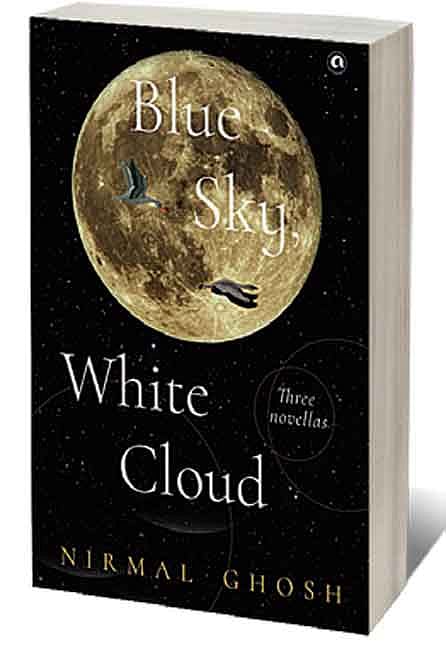Jungle Books

“IT WAS INDEED a human, instantly she was alert, but she sensed no threat. There was no aggression from this human. She herself was still numbed from the loss of not just her cubs but the landscape she had known so well. So, after a while, she decided to leave, and walked away. And as she had done before, she would walk for days, moving forward always leaving the past behind.”
These words from Spirit of the Hills, one of the three novellas in Nirmal Ghosh’s Blue Sky, White Cloud speak volumes about the way wild things are—and the ways in which we get them wrong.
They tell us that the leopard is a she, not an it. They tell us that a leopard is not a bloodthirsty animal driven solely by instinct to attack. She recognises a particular human as benign, she takes a decision to let him be, and to walk away. The leopard has a past, a life of love, loss, kinship, belonging.
This thread of animals as thinking, feeling individuals runs through Blue Sky, White Cloud. Even within the rich body of wildlife literature, Ghosh is that rare author who does not look at non-human animals through an anthropocentric lens. Arati Kumar- Rao’s black-and-white illustrations are equally evocative, a perfect companion to Ghosh’s writing, if not stories in themselves. I wish these had a large display, not relegated to fit a third or so of the page.
2025 In Review
12 Dec 2025 - Vol 04 | Issue 51
Words and scenes in retrospect
The first novella River Storm begins in the 1930s and follows an elephant’s life cycle—the horror of being taken captive as a calf, his dramatic escape, his joyous reunion with his herd, breaking away as an adult and his deep sorrow at losing his ‘mentor’, an old tusker who is poached for his tusks, and his (Bollywood-like) revenge on the culprits.
There is a whiff of nostalgia in the writing, one that (once again) makes one realise how our bonds with the wild grow increasingly tenuous, and erode— and this is reflected in the words of the human protagonist of the story, “people now saw the jungle only as something to be feared and overcome”.
Change, be it in perspective or the environment, is the other constant in the book and is poignantly portrayed in the tusker’s bewilderment as the landscape around him alters: roads carved in jungles, the onset of vehicles, the increasing sprawl of tea gardens etc.
The leopard too must navigate the shrinking forests and expanding human habitation in her hill home in Uttarakhand in the second novella Spirit of the Hills. The story of the leopard is intertwined with that of Hira Singh, a forest guard, their lives of love and loss mirroring each other’s. The author handles this interplay deftly. In both these stories there is a quiet understanding between man and animal like that of star-crossed lovers who know they cannot cross boundaries—“I sit quietly, the leopard sits quietly, sometimes she watches me, sometimes I watch her, sometimes we watch each other.”
This connection between people and wild animals is etched into the narrative, though it is evident such a tie is rare, if not an oddity. Increasingly, the norm, is the conflict when these worlds collide with disastrous consequences for both humans and wildlife.
Blue Sky, White Cloud is markedly different from the other two novellas. This one is fast-paced, has a whiff—but only a whiff—of romance and the makings of an ecological thriller.
For a lay reader these novellas may read like fantastic fiction, as they speak from the animal’s perspective. But those of us with jungle pulsing in our veins, these are the everyday. These are the voices in my head and heart that one ‘hears’ and knows and feels as one works in, and for, wildlife. The people portrayed are very real too—Hira Singh is that forest guard we met over kaali chai in a remote outpost; Deben, the naturalist-villager who forms a bond with ‘his’ elephant, and Nadia, that biologist who will secretly name ‘her’ animals rather than the ‘scientifically correct’ BH6 and BH7.
Conservation may ride on science, but it is a matter from the heart; and that is the essence of this book. Read Blue Sky, White Cloud. In the era of the Anthropocene and the Sixth Extinction, it’s high time that animals have a voice. And are heard.

